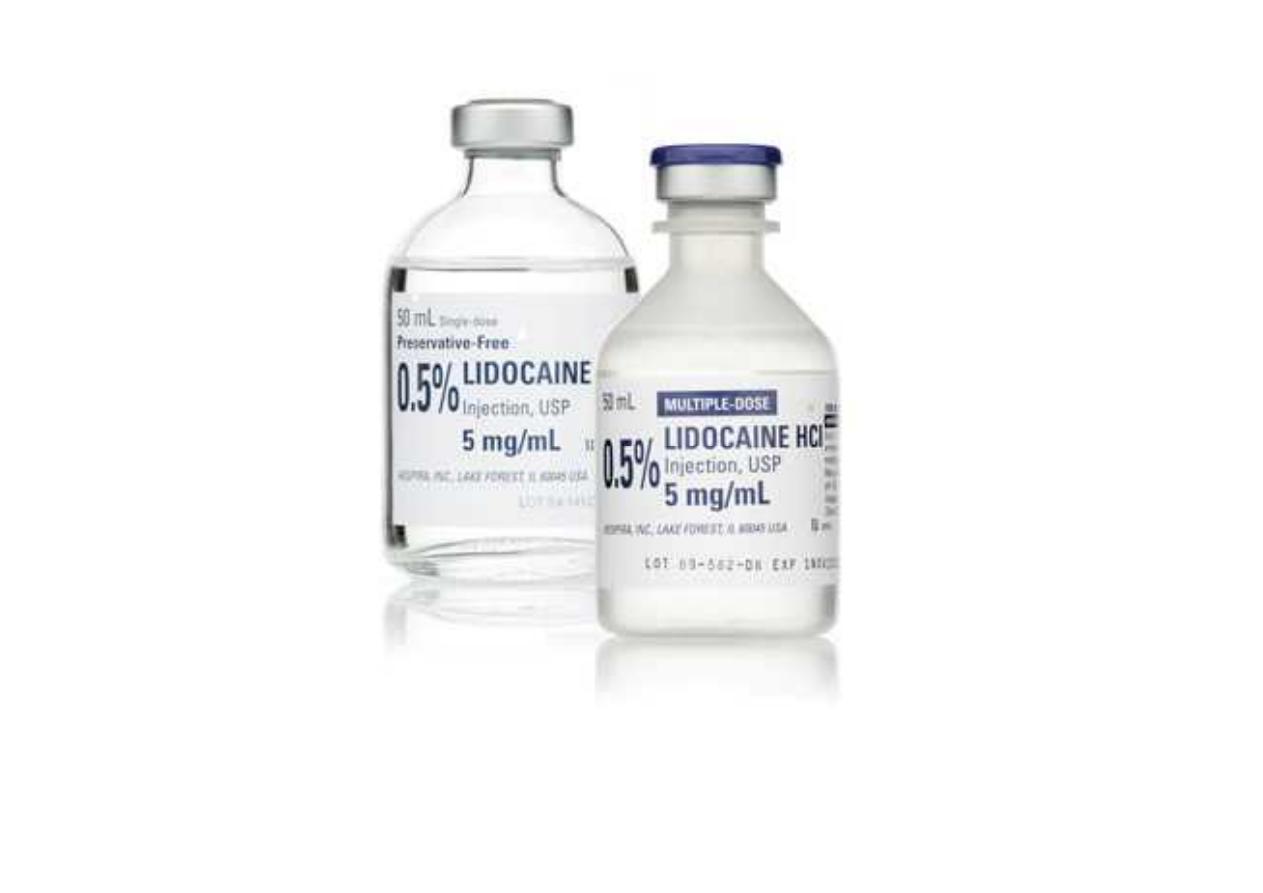
General & Local Anesthesia

General Anesthesia:
Inducing
•
Quick
•
Safe
•
Easily reversible
Unconsciousness for any desired period

Drugs in Anesthesia are given:
1. Before surgery
2. During surgery:
•
Unconsciousness
•
Analgesia
•
Muscle relaxation
3. After surgery:
•
Reversal of neuromuscular block
•
Relief of pain
•
other
Drugs in Anesthesia are given:
1. Before surgery
2. During surgery:
•
Unconsciousness
•
Analgesia
•
Muscle relaxation
3. After surgery:
•
Reversal of neuromuscular block
•
Relief of pain
•
other

Stages of General anesthesia:
Stage One: Analgesia
Stage two: Delirium
Stage Three: Surgical anesthesia
Stage Four: Medullary paralysis, death

1-Before surgery: (Premedication)
A- Anxiolysis and Amnesia.
Patient is apprehensive clear explanation
of what to expect
Reassurance.
Very anxious patient can be helped by
benzodiazepines
1-Before surgery: (Premedication)
A- Anxiolysis and Amnesia.
Patient is apprehensive clear explanation
of what to expect
Reassurance.
Very anxious patient can be helped by
benzodiazepines

B-Analgesia for patient in pain.
Or to:
Prevent post operative pain
-Parenteral opiates morphine
C-Drying of bronchial secretions.
Anti muscarinic drugs
Rarely used
Glycopyrronium is used one hour before surgery
B-Analgesia for patient in pain.
Or to:
Prevent post operative pain
-Parenteral opiates morphine
C-Drying of bronchial secretions.
Anti muscarinic drugs
Rarely used
Glycopyrronium is used one hour before surgery

Gastric content can lead to pulmonary
aspiration:
•
Single dose of anti acid
•
Ranitidine
•
Metoclopramide
*Fasting for at least 6 hours before anesthesia

2-During surgery:
The Aim is to induce:
•
Analgesia
•
Unconsciousness
•
Muscle relaxation (Intra abdominal surgery)

General anesthesia will include two steps:
A- Induction of anesthesia.
B- Maintenance.
A-Induction: Usually IV (Pre-Oxygenated patient)
•
Small doses of opiates
•
Fentanyl
•
Followed by Thiopental (Ultra short acting
Barbiturate)
or: Propofol
General anesthesia will include two steps:
A- Induction of anesthesia.
B- Maintenance.
A-Induction: Usually IV (Pre-Oxygenated patient)
•
Small doses of opiates
•
Fentanyl
•
Followed by Thiopental (Ultra short acting
Barbiturate)
or: Propofol

B-Maintenance: (Inhalation)
•
Nitrous oxide (N2O) and Oxygen
•
Volatile agents +Oxygen + Air.
Isoflurane
Sevoflurane
Halothane
Or
Continuous iv infusion of Propofol (IV)
B-Maintenance: (Inhalation)
•
Nitrous oxide (N2O) and Oxygen
•
Volatile agents +Oxygen + Air.
Isoflurane
Sevoflurane
Halothane
Or
Continuous iv infusion of Propofol (IV)

3-After surgery:
•
Patient is not left alone until
consciousness regained:
•
Effect of neuromuscular blockade
either wane off or reverted by
Antidote.
•
Relief of pain
3-After surgery:
•
Patient is not left alone until
consciousness regained:
•
Effect of neuromuscular blockade
either wane off or reverted by
Antidote.
•
Relief of pain

Dissociative Anesthesia:
•
Profound Analgesia
•
Antegrade Amnesia
•
Minimal Hypnosis

Mode of action:
•
On brain primarily on midbrain reticular
formation system.
•
Lipid solubility is important as the more lipid
soluble is the drug the more its effect on the
brain.
•
GABA receptor activation is also another
proposed mechanism
Mode of action:
•
On brain primarily on midbrain reticular
formation system.
•
Lipid solubility is important as the more lipid
soluble is the drug the more its effect on the
brain.
•
GABA receptor activation is also another
proposed mechanism

Individual Anesthetics:
Gases and Volatile Agents:
(Inhalation anesthesia)
Effect correlate with the partial pressure of anesthetic
agent.
Agents with law solubility in blood provide rapid effect
•
N2O (Nitrous Oxide)
•
Sevoflurane
Individual Anesthetics:
Gases and Volatile Agents:
(Inhalation anesthesia)
Effect correlate with the partial pressure of anesthetic
agent.
Agents with law solubility in blood provide rapid effect
•
N2O (Nitrous Oxide)
•
Sevoflurane

Nitrous Oxide (N2O):
Gas used since 1844
•
Not inflammable
•
Not explosive
•
Light anesthesia

Advantages of Nitrous Oxide: (N2O)
•
Strong Analgesic action
50 % N2O in Oxygen provide profound analgesia.
•
Recovery is very fast
•
Around 4 minutes
Advantages of Nitrous Oxide: (N2O)
•
Strong Analgesic action
50 % N2O in Oxygen provide profound analgesia.
•
Recovery is very fast
•
Around 4 minutes

Disadvantages of Nitrous Oxide : (N2O)
•
Expensive
•
Must be used with more potent drug to produce
surgical anesthesia.
•
Post operative nausea and vomiting
Uses:
Use d to maintain surgical anesthesia with other
agents e.g. Isoflurane
Disadvantages of Nitrous Oxide : (N2O)
•
Expensive
•
Must be used with more potent drug to produce
surgical anesthesia.
•
Post operative nausea and vomiting
Uses:
Use d to maintain surgical anesthesia with other
agents e.g. Isoflurane

Contra indications of Nitrous Oxide (N2O):
Any closed distended air filled space will expand
•
Intra ocular surgery
•
Middle ear
•
lung

Precaution of Nitrous Oxide (N2O):
Adverse reactions:
Nausea and vomiting
When used for more than 4 hours
•
Megaloblastic changes in blood.
•
Teratogenicity to staff?
Precaution of Nitrous Oxide (N2O):
Adverse reactions:
Nausea and vomiting
When used for more than 4 hours
•
Megaloblastic changes in blood.
•
Teratogenicity to staff?

Halogenated anesthetics:
(Volatile Agents)
•
Halothane
•
Isoflurane
•
Sevoflurane

Isoflurane:
•
Volatile colorless liquid
•
Not flammable under normal conditions
•
Pungent odor
•
Can cause bronchial irritation

Effects of Isoflurane:
Respiratory
•
Respiratory depression
•
Increased respiratory rate
CVS:
•
Slight depression in CVS
•
And cardiac output
•
Reduce Blood Pressure and peripheral
vasodilatation.
Effects of Isoflurane:
Respiratory
•
Respiratory depression
•
Increased respiratory rate
CVS:
•
Slight depression in CVS
•
And cardiac output
•
Reduce Blood Pressure and peripheral
vasodilatation.

Sevoflurane:
Chemical analogue to Isoflurane
Enflurane causes more respiratory depression

Halothane (Fluothane):
•
Slow recovery
•
Decrease cardiac output
•
Sensitize heart to catecholamine (Arrhythmia)
•
20% metabolized and induce liver enzymes
•
Fever, anorexia, nausea, vomiting
•
Hepatic damage (rare but serious)
Hepatitis is reported adverse reaction in 1:50000
•
Immune reaction
Halothane (Fluothane):
•
Slow recovery
•
Decrease cardiac output
•
Sensitize heart to catecholamine (Arrhythmia)
•
20% metabolized and induce liver enzymes
•
Fever, anorexia, nausea, vomiting
•
Hepatic damage (rare but serious)
Hepatitis is reported adverse reaction in 1:50000
•
Immune reaction

Intravenous anesthesia:
Extremely rapid induction
It is common practice to use iv induction and
inhalation agents for maintenance.
When volatile anesthesia is stopped it is
eliminated quickly through the lungs.
Intravenous anesthesia:
Extremely rapid induction
It is common practice to use iv induction and
inhalation agents for maintenance.
When volatile anesthesia is stopped it is
eliminated quickly through the lungs.

Propofol:
•
Inductions within 30 sec
•
Recovery is rapid
•
Nausea and vomiting are extremely rare

Thiopental (Pentothal) :
•
Very short acting barbiturate
•
Induces anesthesia smoothly
Dose is 3-5 mg /kg
•
Half life = 4 min allows recovery after a single
dosage (Patient is awake after 10-15 min)
Thiopental (Pentothal) :
•
Very short acting barbiturate
•
Induces anesthesia smoothly
Dose is 3-5 mg /kg
•
Half life = 4 min allows recovery after a single
dosage (Patient is awake after 10-15 min)

Metabolized in the liver
Can damage tissue if exrtravasated
CNS:
•
No analgesia
•
Decrease intracranial pressure
CVS:
•
Hypotension
•
Tachycardia
•
Decrease respiratory rate
Metabolized in the liver
Can damage tissue if exrtravasated
CNS:
•
No analgesia
•
Decrease intracranial pressure
CVS:
•
Hypotension
•
Tachycardia
•
Decrease respiratory rate

Ketamine (Ketalar):
Hallucinogen
Dissociative anesthesia
Sedation amnesia dissociation
Analgesia
15 min after a single IV injection
Can be given IM
Ketamine (Ketalar):
Hallucinogen
Dissociative anesthesia
Sedation amnesia dissociation
Analgesia
15 min after a single IV injection
Can be given IM

Used for Minor surgical interventions
Tachycardia
*Increased blood pressure
Cardiac output
Has an advantage in Shocked patients
Bronchodilatation.

Disadvantages of Ketamine:
•
No muscle relaxation
Increase intracranial and intra ocular pressure
•
Hallucination during recovery
Decrease by diazepam
Disadvantages of Ketamine:
•
No muscle relaxation
Increase intracranial and intra ocular pressure
•
Hallucination during recovery
Decrease by diazepam

Contra indication of Ketamine:
•
Hypertension
•
Congestive cardiac failure
•
Cerebral trauma
•
Increased intracranial pressure
•
Pregnancy (Contra indication in pregnancy)
Contra indication of Ketamine:
•
Hypertension
•
Congestive cardiac failure
•
Cerebral trauma
•
Increased intracranial pressure
•
Pregnancy (Contra indication in pregnancy)

:
Muscle relaxants in Anesthesia
Abdominal surgery requires muscle relaxation
(Deep general anesthesia can cause
relaxation)
Neuromuscular blocking agents
Deep general anesthesia is not advised
Light general anesthesia + selective
neuromuscular block
:
Muscle relaxants in Anesthesia
Abdominal surgery requires muscle relaxation
(Deep general anesthesia can cause
relaxation)
Neuromuscular blocking agents
Deep general anesthesia is not advised
Light general anesthesia + selective
neuromuscular block

Local anesthesia
Mode of action
Prevent the initiation and
propagation of the action potential
(nerve impulse)
Reducing the passage of sodium
through voltage gated sodium
channel
They block conduction
Local anesthesia
Mode of action
Prevent the initiation and
propagation of the action potential
(nerve impulse)
Reducing the passage of sodium
through voltage gated sodium
channel
They block conduction

The distribution of a single dose la is
determined by diffusion into the tissue
Plasma half life is few mints
By infiltration local anesthesia act within 5
min
And have a useful duration of effect for 1-
1.5 hors
Can be doubled by vasoconstriction
Local anesthesia is used as an acid salt =
HCL
The distribution of a single dose la is
determined by diffusion into the tissue
Plasma half life is few mints
By infiltration local anesthesia act within 5
min
And have a useful duration of effect for 1-
1.5 hors
Can be doubled by vasoconstriction
Local anesthesia is used as an acid salt =
HCL

Dissociate in Basic Media
Liberating the active compound HCL
Free base
In abnormally acidic media (abscess)
This dissociation can be delayed
Also risk of spreading infection
Dissociate in Basic Media
Liberating the active compound HCL
Free base
In abnormally acidic media (abscess)
This dissociation can be delayed
Also risk of spreading infection

Absorption of topical anesthesia on
mucus membrane can be extremely
rapid and give plasma concentration
comparable to injection
*This is important specially in urethra
Absorption of topical anesthesia on
mucus membrane can be extremely
rapid and give plasma concentration
comparable to injection
*This is important specially in urethra

Chemical classification of local
anesthetics:
1-Esters:
Cocaine, Procaine, tetracaine,
Benzocaine
2-Amides:
Lignocaine (Xylocaine) Lidocaine
Prilocaine, Pupivacaine
Chemical classification of local
anesthetics:
1-Esters:
Cocaine, Procaine, tetracaine,
Benzocaine
2-Amides:
Lignocaine (Xylocaine) Lidocaine
Prilocaine, Pupivacaine


Effect is terminated by removing
the local anesthetic from the
circulation.
Most LA cause dilatation with the
exception of cocaine
Addition of epinephrine
(Adrenaline) increase the duration of
lidocaine
Effect is terminated by removing
the local anesthetic from the
circulation.
Most LA cause dilatation with the
exception of cocaine
Addition of epinephrine
(Adrenaline) increase the duration of
lidocaine

Never use adrenaline in
Extremities = fingertips
Nose , toes, ..etc
Can lead to Gangrene!
Never use adrenaline in
Extremities = fingertips
Nose , toes, ..etc
Can lead to Gangrene!

Uses of local anesthesia:
1- Surface anesthesia: solution jelly cream
2- Infiltration anesthesia
3- Regional anesthesia
Nerve block
Intravenous regional anesthesia
Epidural anesthesia
Intrathecal ( Spinal anesthesia)
Uses of local anesthesia:
1- Surface anesthesia: solution jelly cream
2- Infiltration anesthesia
3- Regional anesthesia
Nerve block
Intravenous regional anesthesia
Epidural anesthesia
Intrathecal ( Spinal anesthesia)
